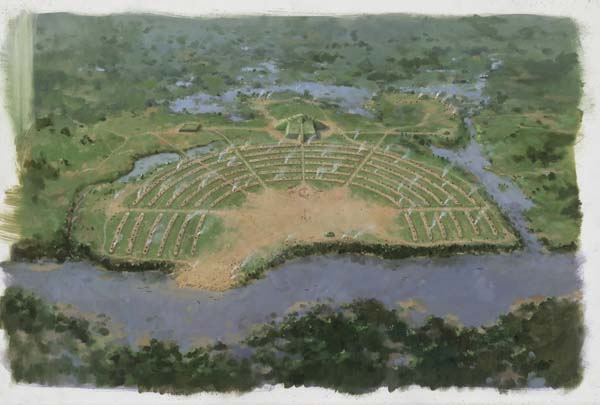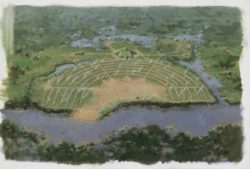Poverty Point Culture
Poverty Point in Louisiana, one of the most significant archaeological sites in in the world, dates to 3,500 years and represents the largest, most complex settlement of its kind in North America.
This entry is 4th Grade level View Full Entry

Martin Pate
Painting of Poverty Point.
What is Poverty Point?
Poverty Point is one of the most important archaeological sites in the world. It is located near the town of Epps in northeast Louisiana. The Native people who lived at this site more than 3,000 years ago, from 1700 to 1100 BCE, created the largest settlement north of Mexico during its time. Poverty Point is known for its large earthen mounds and the extent of its trade network. It is impressive that such things were achieved by people who didn’t farm but were instead hunters and gatherers. It also appears they were egalitarian—that is, they didn’t have powerful leaders who forced people to build the mounds. Archaeologists used to think that a society had to farm and have chiefs to build such a huge site, but Poverty Point has taught them this is not so.
“Poverty Point” is not the name given to the site by the people who built it and lived there. Archaeologists don’t know the name of the tribe responsible for the mounds, or what they named their home. Long after American Indians left the site, a cotton plantation named Poverty Point was established in the early nineteenth century on the property. The archaeological site was named after the plantation.
Archaeologists first began excavating Poverty Point in the early twentieth century. Since then, many archaeologists have worked at the site, learning new things about it but also raising new questions. The story of Poverty Point is a continually changing one.
Why did American Indians build earthen mounds?
Earthen mounds created by American Indians can be found throughout eastern North America, and Louisiana has some of the oldest. The oldest surviving mounds in the state, such as those at Watson Brake and on the Louisiana State University campus in Baton Rouge, are about 6000 years old. Some American Indian groups were still building and using mounds when Spanish explorer Hernando de Soto traveled through the area in 1542 CE. Although Poverty Point’s earthen mounds are not the oldest in the state, they are among the largest. Mound A at Poverty Point is the second-largest precolonial earthen mound in the United States.
At Poverty Point, American Indians moved 981,000 cubic yards or more of dirt by hand to construct five earthen mounds, six earthen ridges, and a large flat plaza. (That’s enough dirt to fill nearly 300 Olympic-sized swimming pools!) A sixth mound was added by another group of people around 700 CE, about 1,800 years later. These mounds are quite different in terms of size, shape, and construction method.
Archaeologists can’t say for sure why American Indians constructed earthen mounds. Some mounds were used as cemeteries, and others were used as foundations for special buildings. There is no clear evidence indicating how the mounds at Poverty Point were used.
What was daily life like at Poverty Point?
Poverty Point is located on Macon Ridge, overlooking the west side of the Mississippi River floodplain. Before the current man-made levee system, the Mississippi River often flooded the valley, creating a swampy floodplain habitat. The elevated ridge would have stayed dry during flooding. People who lived there would have had easy access to many resources including deer, small mammals, nuts, fruits and berries, fish, aquatic roots, and turtles. People there also had access to the Mississippi, Ouachita, and Arkansas Rivers, which were important for contact with other groups.
The people at Poverty Point had a diverse diet. Fishing supplied the bulk of their protein. At one nearby village site, more than 70 percent of food bones were from fish. People ate nuts, which also provided flour and oil, and local plants added carbohydrate-rich edible roots, starchy seeds, and nutritious leaves to their diet.
Archaeologists believe that the people of Poverty Point lived on the ridges of the mounds. Features and artifacts that were used daily, such as hearths and tools, were mostly found there. The C-shaped ridges at Poverty Point are unique; no similar constructions are known anywhere else in the world.
Possibly the greatest challenge of living at Poverty Point was that there was no nearby source of stone. It has been estimated that Poverty Point imported around seventy-eight tons of exotic stone from sources as far as 700 miles away. (That’s about the same weight as ten school buses!) However, archaeologists are not sure how the stone got there. Did the people of Poverty Point go out to collect it themselves, did they trade for it, or did visitors bring it to the site?
The stones were used to make tools people used for survival tasks like hunting, fishing, gathering and preparing food, and building shelters. Stone was also used to create beads and spear points in many shapes and sizes. Plummets—heavy, polished, teardrop-shaped objects—were possibly used as weights for fishing nets or to weave cloth or make baskets.
During this time, people often cooked their food by wrapping it up and burying it with heated rocks in an earthen oven. Because Poverty Point lacked a local source of stone, people used soil with clay in it to make artificial rocks that are now called Poverty Point Objects (PPOs). These “cooking-balls” were made by taking a small handful of moist soil and rolling it between the palms and fingers to shape it. The shaped PPOs were then fired to harden them. When needed, the PPOs were heated back up and used just like hot rocks. Clay objects similar to PPOs are found in many sites across the United States, from California to Florida, wherever there is little local stone. However, the PPOs from Poverty Point are unique because of their abundance and their range of shapes.
Other clay artifacts found at Poverty Point include pipes, figurines, and some pottery fragments. Pottery may have been made locally, but some was brought from as far away as northeast Florida. Poverty Point is especially known for its polished stone beads and pendants—most notably, tiny, potbellied owl pendants made of red jasper. People also shaped copper into beads.
How did people at Poverty Point interact with other people?
Although Poverty Point was unique in the scale of earthmoving and quantity of exotic materials brought there, it was not the only settlement of its age that had mounds, tools, and ornaments made from materials brought from far away. More than two hundred sites with similar objects have been found throughout the southeastern United States. The people who lived at these other settlements were likely in contact with the people of Poverty Point and shared many of the same ideas and activities.
There are multiple ideas explaining how the Poverty Point culture was able to create such a huge site with so much imported stone. Over time, ideas have changed as more information became available. Some archaeologists think that stone tools, like plummets and celts, helped make fishing and gathering more efficient, and therefore gave the people at Poverty Point the resources needed to build the site. Another idea is that Poverty Point was the location of a large region-wide trade fair. However, this idea may not be correct since few goods appear to have left the site; but maybe items like feathers, hides, wooden objects, or woven baskets were part of the exchange and simply did not survive over the years. Most recently, archaeologists have suggested Poverty Point was a pilgrimage site and that stone was brought there by people travelling to the site from far away.
Final Thoughts
The large earthen mounds at the Poverty Point site were not surpassed in size until more than two thousand years later when the Mississippian culture built the Cahokia Mounds near St. Louis, Missouri. Thankfully, the Poverty Point site will be preserved for future generations to study and appreciate. In 2014 it became the 1001st site on the UNESCO World Heritage List, a program that recognizes the world’s most important cultural and natural properties. Continuing archaeological research at the Poverty Point site and other associated sites will contribute to a better understanding of the Poverty Point culture.
